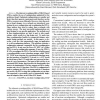Free Online Productivity Tools
i2Speak
i2Symbol
i2OCR
iTex2Img
iWeb2Print
iWeb2Shot
i2Type
iPdf2Split
iPdf2Merge
i2Bopomofo
i2Arabic
i2Style
i2Image
i2PDF
iLatex2Rtf
Sci2ools
DATE
2009
IEEE
2009
IEEE
Automatically mapping applications to a self-reconfiguring platform
The inherent reconfigurability of SRAM-based FPGAs enables the use of configurations optimized for the problem at hand. Optimized configurations are smaller and faster than their generic counterparts and therefore use the FPGAs resources more efficiently. However, when the problem at hand changes, two overheads are introduced: generating the new configuration and reconfiguring the FPGA. Many authors have tried to reduce these overheads with various success. The most successful implementations are hand designs for one specific application. The methods used in these implementations are hard to port to other applications, which results in a big design cost. To make runtime reconfiguration feasible in commercial designs, automated design methods are needed. In this paper, we describe a tool flow that automatically maps an application to a self-reconfiguring platform. This platform contains a configuration manager, responsible for the reconfiguration and an FPGA. In our case the Power PC (P...
DATE 2009 | FPGA | FPGA Configuration | Hardware | Tool Flow |
Related Content
| Added | 16 Aug 2010 |
| Updated | 16 Aug 2010 |
| Type | Conference |
| Year | 2009 |
| Where | DATE |
| Authors | Karel Bruneel, Fatma Abouelella, Dirk Stroobandt |
Comments (0)

